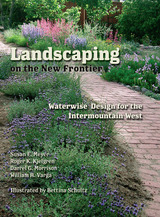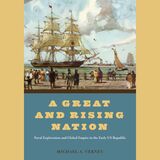3 books about Natural landscaping

Landscaping on the New Frontier
Waterwise Design for the Intermountain West
Susan E. Meyer, Roger K. Kjelgren, Darrel G. Morrison, and William A. Varga
Utah State University Press, 2009
A practical volume for the home or business owner on landscaping with native, drought-tolerant plants in the Rocky Mountain West. Filled with color illustrations, photos, and design sketches, over 100 native species are described, while practical tips on landscape design, water-wise irrigation, and keeping down the weeds are provided.
In this book you will learn how to use natural landscapes to inspire your own designed landscape around your business or home and yard. Included are design principles, practical ideas, and strong examples of what some homeowners have already done to convert traditional "bluegrass" landscapes into ones that are more expressive of theWest. Landscaping on the new Frontier also offers an approach to irrigation that minimizes the use of supplemental water yet ensures the survival of plants during unusually dry periods. You will learn how to combine ecological principles with design principles to create beautiful home landscapes that require only minimal resources to maintain.
In this book you will learn how to use natural landscapes to inspire your own designed landscape around your business or home and yard. Included are design principles, practical ideas, and strong examples of what some homeowners have already done to convert traditional "bluegrass" landscapes into ones that are more expressive of theWest. Landscaping on the new Frontier also offers an approach to irrigation that minimizes the use of supplemental water yet ensures the survival of plants during unusually dry periods. You will learn how to combine ecological principles with design principles to create beautiful home landscapes that require only minimal resources to maintain.
[more]

Native To The Nation
Disciplining Landscapes And Bodies In Australia
Allaine Cerwonka
University of Minnesota Press, 2004
In a world increasingly marked by migration and dislocation, the question of displacement, and of establishing a sense of belonging, has become ever more common and ever more urgent. But what of those who stay in place? How do people who remain in their place of origin or ancestral homeland rearticulate a sense of connection, of belonging, when ownership of the territory they occupy is contested? Focusing on Australia, Allaine Cerwonka examines the physical and narrative spatial practices by which people reclaim territory in the wake of postcolonial claims to land by indigenous people and new immigration of “foreigners.” As a multicultural, postcolonial nation whose claims to land until recently were premised on the notion of the continent as “empty” (terra nullius), Australia offers an especially rich lens for understanding the reterritorialization of the nation-state in an era of globalization. To this end, Native to the Nation provides a multisited ethnography of two communities in Melbourne, the Fitzroy Police Station and the East Melbourne Garden Club, allowing us to see how bodies are managed and nations physically constructed in everyday confrontations and cultivations. Allaine Cerwonka is assistant professor of women’s studies and political science at Georgia State University.
[more]

Roadside Use of Native Plants
Edited by Bonnie L. Harper-Lore and Maggie Wilson
Island Press, 2000
Originally published by the U.S. Department of Transportation's Federal Highway Administration (FHWA), Office of Natural Environment to promote the planting and care of native plants along highway rights-of-way, this unique handbook provides managers of roadsides and adjacent lands with the information and background they need to make site-specific decisions about what kinds of native plants to use, and addresses basic techniques and misconceptions about using native plants. It brings together in a single volume a vast array of detailed information that has, until now, been scattered and difficult to find.The book opens with eighteen short essays on principles of ecological restoration and management from leading experts in the field including Reed F. Noss, J. Baird Callicott, Peggy Olwell, and Evelyn Howell. Following that is the heart of the book, more than 500 pages of comprehensive state-by-state listings that offer: a color map for each state with natural vegetations zones clearly marked comprehensive lists of native plants, broken down by type of plant (grasses, forbs, trees, etc.) and including both scientific and common names, with each list having been verified for completeness and accuracy by the state's natural heritage program contact names, addresses, and phone numbers for obtaining current information on invasive and noxious species to be avoided resources for more information, including contact names and addresses for local experts in each state The appendix adds definitions, bibliography, and policy citations to clarify any debates about the purpose and the direction of the use of native plants on roadsides.Roadside Use of Native Plants is a one-of-a-kind reference whose utility extends far beyond the roadside, offering a toolbox for a new aesthetic that can be applied to all kinds of public and private land. It can help lead the way to a cost-effective ecological approach to managing human-designed landscapes, and is an essential book for anyone interested in establishing or restoring native vegetation.
[more]
READERS
Browse our collection.
PUBLISHERS
See BiblioVault's publisher services.
STUDENT SERVICES
Files for college accessibility offices.
UChicago Accessibility Resources
home | accessibility | search | about | contact us
BiblioVault ® 2001 - 2024
The University of Chicago Press









